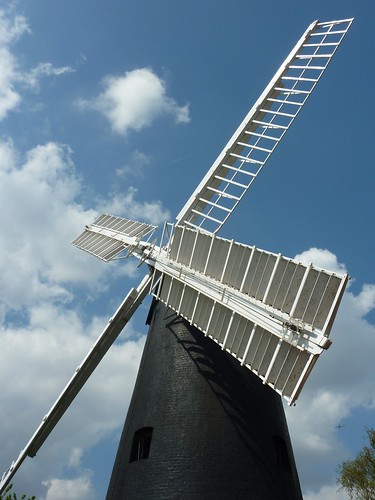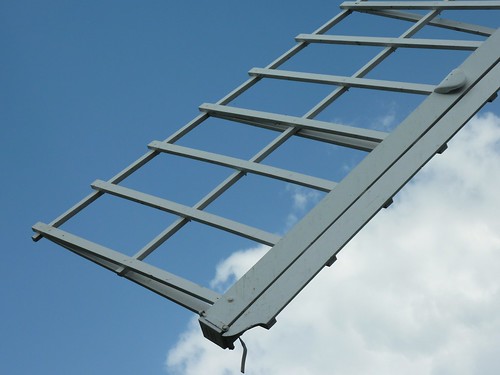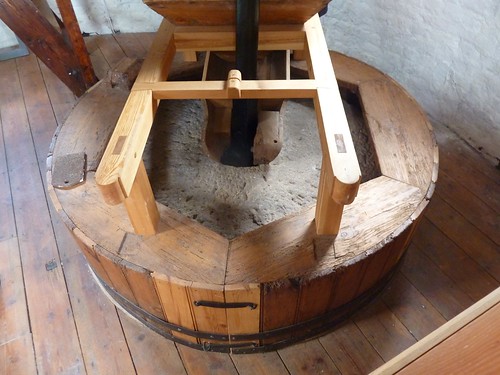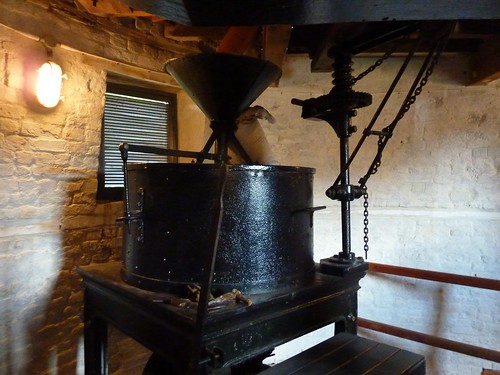Gosh it's been a while, hasn't it? Sorry about that, but I've been really busy. You may recall the expended period of unemployment that followed the finish of my work on last year's Olympic ceremonies. Well it turns out that freelance production management work in London seems to operate on the same schedule as the buses. That is, you wait ages for one to come along, and then two arrive at the same time. In my case the two were gigs for Soho Theatre and Hampstead Theatre. The schedule was not ideal, with the tech period for the Soho show starting a mere three days after the Hampstead show opened. This meant that I spent most of April in a sort of mad haze dashing from theatre to workshop to theatre and back. And with this size of theatre production management is very much a hands-on affair, which resulted in a fair bit of time lifting heavy things on and off trucks or standing at the top of a ladder tangled in miles of black string or cursing an M10 nut that had rolled just out of reach under a dusty bit of deck, in the dark. Luckily for me the end is in sight and I hope to return to my former life of indolent café-dwelling in about a week or so. Luckily for you I've actually had one or two days off in which to do blog-worthy things, some of which were far-flung, and some of which were almost in my own back yard, like the topic of today's long-awaited return to blogging: Brixton Windmill.
I know I get a bit gushy about London sometimes, but honestly how can you not love a city where you can walk one block off a main road and find a restored 19th century windmill sandwiched between a rather large housing estate and a prison? (And on a prisons-related note: London is home to two of the most brilliantly named prisons ever. The well-known Wormwoods Scrubs in northwest London held my personal title as Most Excellently Named Prison until it was supplanted when I learned of the now-disappeared institution formerly located in Clerkenwell called Coldbath Fields Prison. You just couldn't make this stuff up.)
But back to the windmill. There was a rare confluence of events a couple of Mondays ago: I had the day off, and it was a Bank Holiday, AND the weather was pleasant and sunny. There were even bluebells out! (Bluebells have a sort of cult status here, and their arrival in the spring is a notable event. It's a popular past time to go walking in bluebell woods to see the forest floor carpeted with them.)
Brixton Windmill was built in 1816 and leased by a Quaker family - the Ashbys - who used it to mill stoneground flour for a couple of generations. By 1862 the increased density of building in the area reduced the amount of wind available, meaning the mill was no longer functional. It remained dormant until 1902 when the Ashbys returned and equipped it with a steam-powered Provender Mill, a tiny device that could produce as much milled grain in a day as the wind-powered mill could, and could do it consistently. The mill ceased operation in the 1930s and the sweeps were taken down. In the 1950s it was listed as a Grade II property and a small park was laid out around it called Windmill Gardens. The windmill itself was partially restored in the 1960s, with the sweeps reinstated. However, it continued to decay and was vandalised and somewhat forgotten until it was officially recognised as being "at risk" in 2002. In 2003 Friends of Windmill Gardens were set up to try to restore the windmill once again. They campaigned for and won lottery funding and the restoration work tool place in 2010. The newly restored windmill was opened in 2011, and holds regular Open Days, one of which was on the aforementioned sunny Monday.
Long before my schedule exploded, I'd pre-booked a guided tour of the windmill, a necessary step because they only allow four people on the upper levels of the mill, meaning that one guide can take three people at a time, so the slots fill up quickly. The restored windmill is gorgeous inside. There's lots of whitewashed brick and big honey-coloured timbers and precipitous staircases and lots and lots of giant cogs and bits that are supposed to spin and such. (Warning to Karen: gears aplenty coming up!)
No really, it's an actual WINDMILL.
But back to the windmill. There was a rare confluence of events a couple of Mondays ago: I had the day off, and it was a Bank Holiday, AND the weather was pleasant and sunny. There were even bluebells out! (Bluebells have a sort of cult status here, and their arrival in the spring is a notable event. It's a popular past time to go walking in bluebell woods to see the forest floor carpeted with them.)
Not exactly a carpet of bluebells.
Long before my schedule exploded, I'd pre-booked a guided tour of the windmill, a necessary step because they only allow four people on the upper levels of the mill, meaning that one guide can take three people at a time, so the slots fill up quickly. The restored windmill is gorgeous inside. There's lots of whitewashed brick and big honey-coloured timbers and precipitous staircases and lots and lots of giant cogs and bits that are supposed to spin and such. (Warning to Karen: gears aplenty coming up!)
I like to call this one "Sunlight on Gears"
One of the common sails, unrigged.
The general annoyance of dealing with common sails lead to the development of patent sails. Patent sails are equipped with a set of hard louvres that could be opened or closed with a hand crank and are therefore way easier to deal with than the common sails. Sadly, patent sails are not nearly as good at catching wind as common sails, which is just typical, isn't it? That's why the Brixton windmill has two of each type.
A patent sail.
The sails are attached to the cap of the windmill, which looks a bit like an upturned rowboat and sits on top of the windmill. The cap cap actually be turned from the inside (with gears!) which allows the miller to orient the sails to the wind.
The cap of the windmill.
Once the sweeps are turning, the shaft of sweeps spins and that horizontal spinning motion is converted vertical spinning motion with - you guessed it - gears!
Fascinatingly, anywhere gears mesh in the mill only one gear in the pair is metal. The other is always built with wooden teeth. This is to eliminate metal-on-metal contact which might cause sparks in the highly explosive atmosphere filled with finely ground dust. (Karen: don't try to pretend that's not interesting.)
The vertical spinning shaft is attached - a few floors down - to the millstones.
The actual grindy bit
The unmilled grain is poured through a hole in the top stone (called the runner stone), and is ground between the top stone, which spins, and the bottom stone (called the bed stone), which stays static. The resulting flour works its way out to the edges of the stones and is collected. (And in a wordy aside: any unmilled grain is called grist, as in the phrase "it's all grist for the mill".) The resulting flour could be milled again to produce a finer grind. And the stones themselves are actually cut in a pattern, which also affects the grind. Sometimes mills would even be equipped with two sets of stones to mill two kinds of flour, all driven from the same central shaft through the power of gears!
An old millstone on the lawn outside the windmill
As I mention earlier, the mill was revived in 1902 when the Ashbys returned and equipped it with a Provender mill. A Provender Mill is a small, freestanding cast-iron device invented to mill grain without the need for giant buildings with unwieldy sails. It's somewhat ironic that the Ashbys chose to site their Provender Mill inside the old windmill when they could just as easily have put it in a warehouse or a barn. Maybe they missed all those nice gears. The Friends of Brixton Windmill are hoping to get the provender mill running again so that they can actually produce flour, but they're running into money problems and Elfin Safety issues and such. Still, they're hoping to get grinding again by 2016, which is the mill's 200th anniversary.
The provender mill, which originally ran on steam power, and then on gas, and has now been converted to run on one tiny little electric motor. Boringly, most of its gears are small and hidden.
The actual tour of the windmill only took about 45 minutes, and the surrounding festivities - a slightly sad tea room and bake sale and a somewhat ragtag group of musicians - were not overly compelling. Still, the place was full of people enjoying the sunshine, and kids frolicking in the adjoining playground, which I'd say is largely due to the drawing power of a really nice big bunch of gears.
Me, and a bit of the windmill in the background.














2 Comments:
I love gears. You can give them to me anytime. Thanks for the Pam snap too. Does this mean your hair is long enough to be gathered with some kind of hair scrunchy thing? Radical! xo RH
Post a Comment